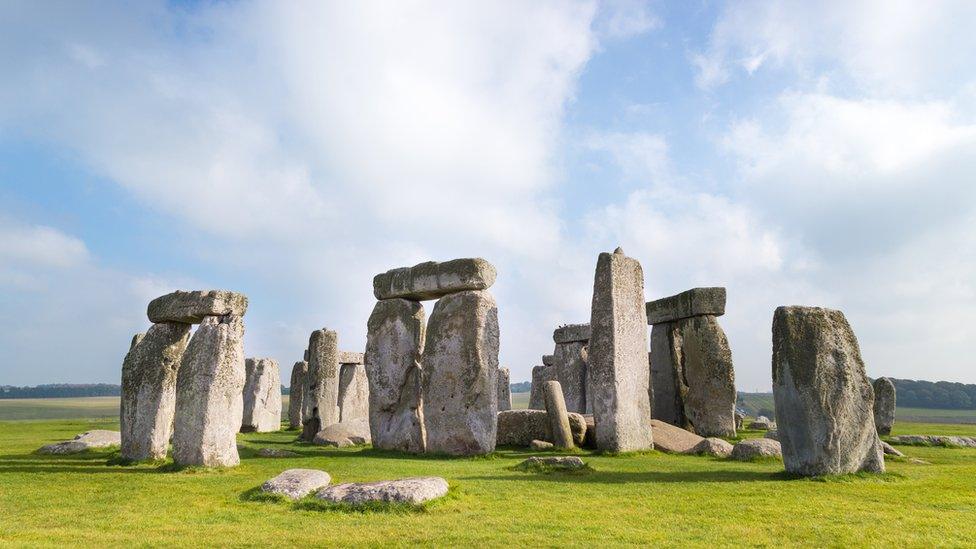UNESCO: Which areas could become World Heritage sites?
- Published
- comments

Stonehenge is one of the UK's most famous existing World Heritage sites
Seven sites in the UK and its overseas territories could be in the running to win Unesco World Heritage status in the future.
Among the locations put forward are York city centre, Birkenhead Park and an iron age settlement in Shetland.
World heritage status is given to somewhere that is globally recognised as a place of cultural, historical or scientific significance.
It's a stamp of international reputation which can also lead to more visits from tourists and can help when trying to raise funds for things like renovations.
The Tower of London, where building began in 1066, is already on the list
Every 10 years, the government puts forward locations to join the prestigious list put together by Unesco, an agency of the United Nations.
Five of the sites have been added to the government's list - which highlights the locations it feels have the best chance of being granted the special status - while two sites are already on the list from earlier this year.
Laura Davies, HM Ambassador to Unesco, said the five new sites "brilliantly reflect the diversity and beauty of the UK and its overseas territories' natural and cultural heritage".
There are already 33 World Heritage sites in the UK, including Stonehenge.
Globally, the sites on the list overseen by the agency of the United Nations, include Australia's Great Barrier Reef and historic areas of Cairo.
Unesco says the ruins of Machu Picchu in Peru show the Inca Empire at its height with giant walls, terraces and ramps seemingly cut naturally into the Andes mountains
The Department for Culture, Media and Sport said it would work with local authorities and devolved administrations to develop their bids.
Heritage Minister Lord Parkinson of Whitley Bay said: "All the locations being put forward would be worthy recipients of this accolade - and we will give them our full backing so they can benefit from the international recognition it can bring."
What are the new locations?
York
York city centre is known for its rich history
A city with a rich history from the Anglo-Saxon, Viking and Normans who previously lived there.
It has civic and religious buildings including York Minister, one of the world's most magnificent cathedrals which has been in use since the 7th century.
Birkenhead Park
Birkenhead Park inspired the development and creation of parks across the world including New York's Central Park
This park in Merseyside in the north west of England was opened in 1847 and, at the time, was an exciting new project experimenting with how to bring greenery to city environments.
It also inspired the development and creation of parks across the world including New York's very famous Central Park.
Shetland Iron Age settlements
The Zenith of Iron Age Shetland is a collection of three ancient settlements dating back thousands of years
This special collection of three ancient settlements can be found of the island of Shetland, off the coast of Scotland.
They date back thousands of years.
The East Atlantic Flyway
The passage forms a migratory bird route over western parts of Europe, including Yorkshire, Lincolnshire, Norfolk, Suffolk, Essex and Kent.
It's been added to the list in recognition of its vital importance to bird populations and wildlife as an area that sees huge transient bird populations pass through every year.
The Little Cayman Marine Parks and Protected Areas
The Little Cayman Marine Parks and Protected Areas, in the UK overseas territory of the Cayman Islands, have also been put forward
The Cayman Islands is one of the UK's overseas territories, of which there are 14 across the globe.
These sites have also been put forward for their exceptional importance to marine biodiversity and their incredible natural beauty.
Which locations have already been proposed ?
The Flow Country
The Flow Country contains the most intact and extensive blanket bog system in the world
This large area of peatland across Caithness and Sutherland in the north of Scotland plays a crucial role in supporting biodiversity.
The expanse of peatlands, bogs, pools, lochs, hills and mountains covers large parts of the north Highlands.
Gracehill Moravian Church Settlement
Gracehill Moravian Church is one of five Moravian churches in Northern Ireland
Gracehill village was founded 264 years ago, and it's application to Unesco was part of a joint bid with Bethlehem in Pennsylvania in the United States and Herrnhut in Germany.
All three sites are Moravian Church Settlements.
The Giant's Causeway was designated as a Natural World Heritage site in 1986, but if successful Gracehill would be the first in Northern Ireland to be granted Cultural World Heritage status.
- Published18 November 2019
- Published8 July 2019
